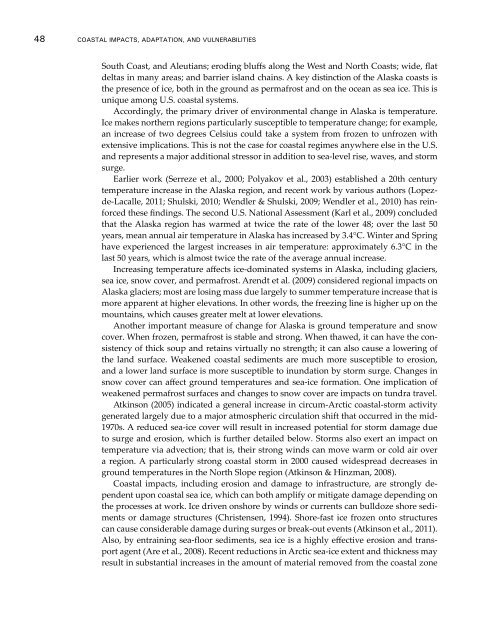Coastal Impacts, Adaptation, and Vulnerabilities - Climate ...
Coastal Impacts, Adaptation, and Vulnerabilities - Climate ...
Coastal Impacts, Adaptation, and Vulnerabilities - Climate ...
Create successful ePaper yourself
Turn your PDF publications into a flip-book with our unique Google optimized e-Paper software.
48 <strong>Coastal</strong> <strong>Impacts</strong>, <strong>Adaptation</strong>, <strong>and</strong> <strong>Vulnerabilities</strong>South Coast, <strong>and</strong> Aleutians; eroding bluffs along the West <strong>and</strong> North Coasts; wide, flatdeltas in many areas; <strong>and</strong> barrier isl<strong>and</strong> chains. A key distinction of the Alaska coasts isthe presence of ice, both in the ground as permafrost <strong>and</strong> on the ocean as sea ice. This isunique among U.S. coastal systems.Accordingly, the primary driver of environmental change in Alaska is temperature.Ice makes northern regions particularly susceptible to temperature change; for example,an increase of two degrees Celsius could take a system from frozen to unfrozen withextensive implications. This is not the case for coastal regimes anywhere else in the U.S.<strong>and</strong> represents a major additional stressor in addition to sea-level rise, waves, <strong>and</strong> stormsurge.Earlier work (Serreze et al., 2000; Polyakov et al., 2003) established a 20th centurytemperature increase in the Alaska region, <strong>and</strong> recent work by various authors (Lopezde-Lacalle,2011; Shulski, 2010; Wendler & Shulski, 2009; Wendler et al., 2010) has reinforcedthese findings. The second U.S. National Assessment (Karl et al., 2009) concludedthat the Alaska region has warmed at twice the rate of the lower 48; over the last 50years, mean annual air temperature in Alaska has increased by 3.4°C. Winter <strong>and</strong> Springhave experienced the largest increases in air temperature: approximately 6.3°C in thelast 50 years, which is almost twice the rate of the average annual increase.Increasing temperature affects ice-dominated systems in Alaska, including glaciers,sea ice, snow cover, <strong>and</strong> permafrost. Arendt et al. (2009) considered regional impacts onAlaska glaciers; most are losing mass due largely to summer temperature increase that ismore apparent at higher elevations. In other words, the freezing line is higher up on themountains, which causes greater melt at lower elevations.Another important measure of change for Alaska is ground temperature <strong>and</strong> snowcover. When frozen, permafrost is stable <strong>and</strong> strong. When thawed, it can have the consistencyof thick soup <strong>and</strong> retains virtually no strength; it can also cause a lowering ofthe l<strong>and</strong> surface. Weakened coastal sediments are much more susceptible to erosion,<strong>and</strong> a lower l<strong>and</strong> surface is more susceptible to inundation by storm surge. Changes insnow cover can affect ground temperatures <strong>and</strong> sea-ice formation. One implication ofweakened permafrost surfaces <strong>and</strong> changes to snow cover are impacts on tundra travel.Atkinson (2005) indicated a general increase in circum-Arctic coastal-storm activitygenerated largely due to a major atmospheric circulation shift that occurred in the mid-1970s. A reduced sea-ice cover will result in increased potential for storm damage dueto surge <strong>and</strong> erosion, which is further detailed below. Storms also exert an impact ontemperature via advection; that is, their strong winds can move warm or cold air overa region. A particularly strong coastal storm in 2000 caused widespread decreases inground temperatures in the North Slope region (Atkinson & Hinzman, 2008).<strong>Coastal</strong> impacts, including erosion <strong>and</strong> damage to infrastructure, are strongly dependentupon coastal sea ice, which can both amplify or mitigate damage depending onthe processes at work. Ice driven onshore by winds or currents can bulldoze shore sedimentsor damage structures (Christensen, 1994). Shore-fast ice frozen onto structurescan cause considerable damage during surges or break-out events (Atkinson et al., 2011).Also, by entraining sea-floor sediments, sea ice is a highly effective erosion <strong>and</strong> transportagent (Are et al., 2008). Recent reductions in Arctic sea-ice extent <strong>and</strong> thickness mayresult in substantial increases in the amount of material removed from the coastal zone
















